I’ve continued to think about the imagery in the combat scene, and in the process, I have altered my notions of mental combat.
I have spent time gathering images of clouds, mists, wisps of smoke, and nebulae. I haven’t yet hit upon what I like, but one idea keeps coming back: write “de-stellarizing” software that scans one of the hundreds of NASA photos of nebulae and removes the stars, leaving just nebulae. Then desaturate these images (reduce them to black and white), then re-colorize them with various RGB combinations and use those to represent my dream universe. Just now I’m hesitating because I fear that the “de-stellarizing” software will not be a quick one-day task as I’d like to believe. I don’t want to spend days upon days messing around trying to get the perfect solution.
I went through some evolution on the concept of mind combat. In original Siboot, it was a simple integer rock-scissors-paper game: you had a small number of each of the three auras, you were trying to assemble a balanced set with equal numbers of each aura, and you’d deploy a particular aura against your opponent based on your prediction of his likely behavior based on knowing his aura counts.
My first idea was to make mind combat less agonistic by making it an exchange of auras. This would permit two characters to agree beforehand to swap auras during dream time – which included the possibility of betrayal. However, it took only a few minutes’ thought to realize that such a system would seldom lead to anybody getting an advantage over others.
Lying in bed this morning, I realized that there’s no need to treat auras as countable. Rather, they can be fractional. Think in terms of color; I’ll be assigning red, green, and blue to the three auras. The goal in the game is to assemble a personal aura RGB combination of (1..0, 1.0, 1.0): perfect white. Everybody starts off with some lopsided combination of auras, and mind combat permits you to increase your aura values by taking some aura from an opponent.
But what is the mechanism of mind-combat? Success must be contingent upon a correct assessment of the opponent’s aura-state. Suppose, for example, that you believe that an opponent’s aura state is this:
![]()
I’m rather pleased with the idea of communicating an entire state with a single color. This state could be more explicitly presented like so:
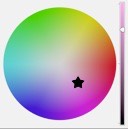
It tells us that this character is strong in red, almost as strong in blue, but quite deficient in green, which tells us that he’ll be trying to obtain some more green.
Perhaps I should make it impossible for the player to adjust his combat settings: you go into mind combat the way you are and so does your opponent. For example, suppose we get combat between two characters with the following aura sets:
(0.66, 0.19, 0.42) versus (0.55, 0.88, 0.21)
Let’s further postulate the intransitivity relationship to be R > G > B > R. How do we combine these numbers? My first stab is to set up pairings like so:
0.66R versus 0.88G
0.19G versus 0.21B
0.42B versus 0.55R
but why couldn’t we just as well use this:
0.55R versus 0.19G
0.88G versus 0.42B
0.21B versus 0.55R
Perhaps we should do both. In any case, what’s the result of these pairings? I would think that the victorious color steals an equal amount of the defeated color. But in what sequence are the operations performed? If the first set of operations is performed before the second set, then the second character gets clobbered. Perhaps they could be performed in virtual simultaneity, like so:
0.66R versus 0.88G yields 0.66G for player #1
0.19G versus 0.21B yields 0.19B for player #1
0.42B versus 0.55R yields 0.42R for player #1
0.55R versus 0.19G yields 0.19G for player #2
0.88G versus 0.42B yields 0.42B for player #2
0.21B versus 0.55R yields 0.21R for player #2
Now we add up the results:
Player #1:
R = 0.66 + 0.42 - 0.21 = 0.87
G = 0.19 + 0.66 - 0.19 = 0.66
B = 0.42 + 0.19 - 0.42 = 0.19
Player #2
R = 0.55 + 0.21 - 0.42 = 0.34
G = 0.88 + 0.19 - 0.66 = 0.41
B = 0.21 + 0.42 - 0.19 = 0.44
Thus, Player #1 went from (0.66, 0.19, 0.42) to (0.87, 0.66, 0.19)
While Player #2 went from (0.55, 0.88, 0.21) to (0.34, 0.41, 0.44)
Player #1 gained more out of this combat than Player #2. BUT Player #1 now has a more unbalanced aura set than Player #2. Can this mechanic be understood well enough to be used? Can a player look at the colors and figure out the best combinations? Let’s express this in terms of the color wheel:
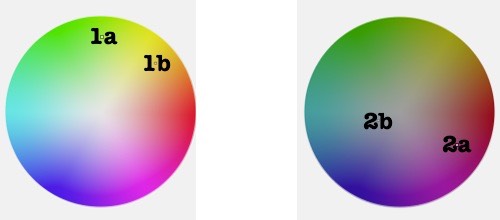
In this image, Player #1 moved from 1a to 1b, and Player #2 moved from 2a to 2b. What doesn’t show here is the change in brightness; the overall brightness of a and b parts of the images were merged, so it is not clear that Player #1 brightened and Player #2 darkened. If you ignore that, it looks like Player #2 came out of the combat better.
This is no good. I need a visual rule, something that permits a player to look at the colors and decide whether combat is desirable. Let’s simplify the problem and consider only the wheel at its brightest:
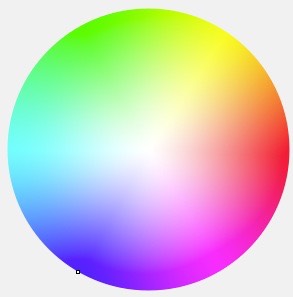
What kind of mechanic could people consider in such a case? I suppose that the best one would be something based on rotation: if you’re clockwise from me, I’ll beat you, but if you’re counterclockwise, I’ll lose to you. Consider these situations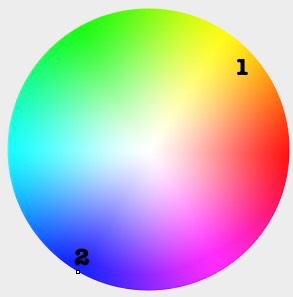

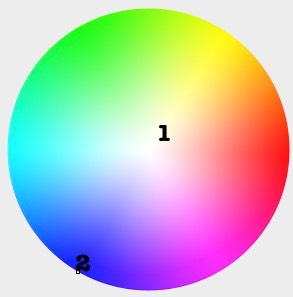
In the first situation, Player #1 would gain greatly by attacking Player #2, because we’d expect the result of an attack to be to move the attacking player towards the defending player. But what about uncertainty? What if Player #1 thinks that the first situation obtains, but in reality it’s the second situation? In that case, Player #1 would lose the combat and Player #2 would be moved closer to the center.
Now consider the third situation. In this combat, would not Player #1 be pulled too far towards Player #2? Problems. Let’s look at the bigger picture. Here’s how the player might assess the overall situation just before mind combat:
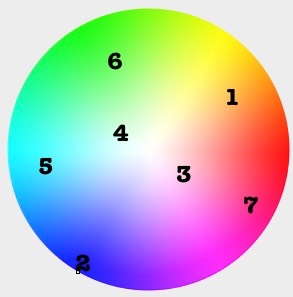
You’re Player #1; is there any way that you could read this figure to make a good decision as to whom you might attack? Perhaps the mechanic is simple: whenever you attack somebody, you BOTH move towards each other by one-third of the distance separating you. Or we could say that attacking somebody moves you to the point exactly halfway between your position and the defender’s.
I don’t know, this is getting way too spatial for my taste. I don’t want the player estimating angles and distances. I want a more intuitive process. Perhaps it’s just a matter of interpretation. What if, instead of presenting a color wheel, we presented the individual colors. Here’s what Player #1 might see:

Just looking at this image, is it possible to formulate an effective strategy? Could a player look at this and think, “I’m halfway between red and green, so I need to avoid #6 and #7. Instead, I want to focus on #2 or maybe #5. But I should not forget that both #3 and #4 are closer to pure white than I am; perhaps I should do a spoiling attack against them?”
Does this demand too much “color intelligence”? Can it backfire for somebody who doesn’t have a mental color wheel? Can people look at these colors and figure out pretty well how much of a combination of red, green, and blue they represent?
Wouldn’t this be better if it were more explicitly linked to the emotional states (niceness, integrity, and power)? Suppose, for instance, that red represents power, green represents integrity, and blue represents niceness. Could we then look at these colors and declare that Player #1 has lots of plower and integrity, but lacks niceness? That Player #2 is extremely nice but little else?
I have asked enough questions for one day.
